Real Estate Crash The Next Shoe To Drop – Part III
Our continued research into the state and status of the Real Estate market continues to point to a process that is starting to unfold in the US which may put price and activity levels at risk. Within the past two segments of this research article, we’ve highlighted how market cycles and recent market data point to a Real Estate market that may be in the early stages of a downward price cycle.
Additionally, within Part II of this article, we highlighted the human psychological process of dealing with a crisis event which also suggests a deepening price contraction event may take place within the next 12 to 24+ months.
US New Home Sales data was just released
We believe the psychological process is just starting to become evident in the current data. For example, the US New Home Sales data was just released and it shows the sharpest decline in activity since June 2010 (nearly 14 months after the actual bottom in the US stock market in March 2009).
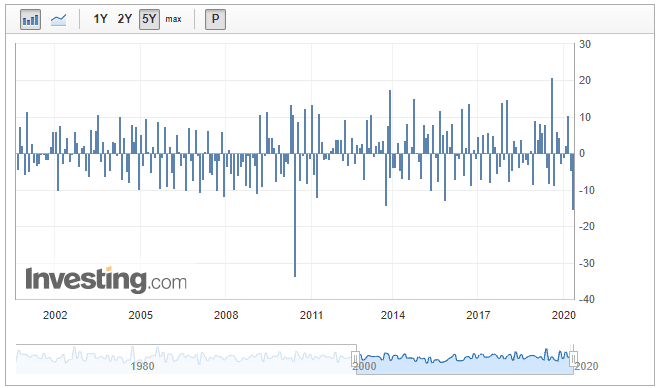
Our researcher team believes investors/traders and many consumers have become complacent with the current data and are simply in denial in attempting to relate future economic outcomes to the current set of circumstances. There has never been anything like this to disrupt global economic activity and consumer engagement over the past 100+ years. Not even the Great Depression or WWII was on this scale.
When you stop to consider the scale and scope of this COVID-19 virus event and the process of recovery, one should really ask serious questions about how quickly you believe the global economy will be able to recover to 2018/2019 economic activity levels, how quickly the world can create and sustain 25~75 million new jobs, and how quickly global nations can attempt to regain GDP output levels nearly equal to 2018/2019 levels?
Before we continue, be sure to opt-in to our free market trend signals
before closing this page, so you don’t miss our next special report!
IYR Monthly chart
Take a look at this IYR Monthly chart, below. The initial collapse in the markets in 2007 was the start of a similar type of economic and psychological crisis event. Notice how IYR started to move lower in early 2007 – well before the real collapse in the US economy began in December 2008. Another aspect to consider is how long it took for IYR to recover back to near 2007 levels. From the bottom in early 2009, it took nearly 6 years for IYR to reach levels above $80 again.
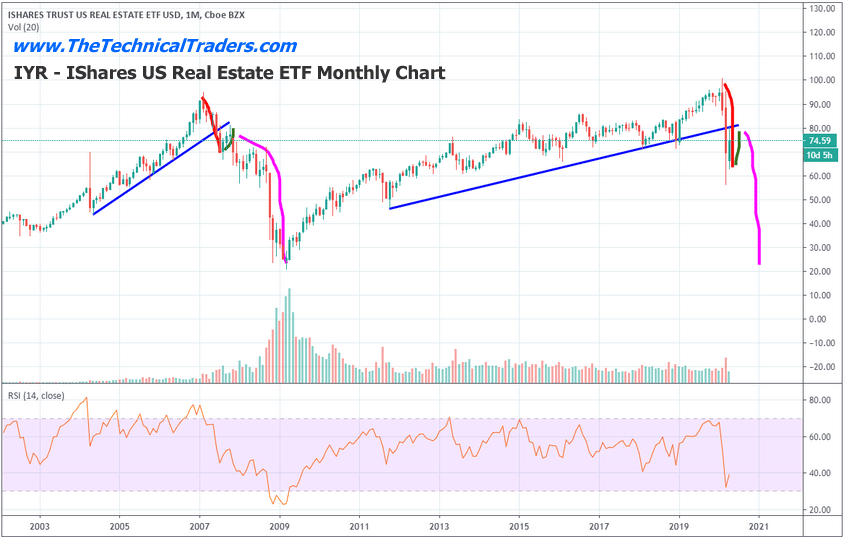
Case-Shiller US Home Price Index chart
This Case-Shiller US Home Price Index chart shows a similar setup taking place. The peak in home price values on this chart happened in early 2006 – well before the peak on the IYR chart in early 2007. The interesting component of this Case-Shiller chart is that real home price values didn’t bottom until early 2012 whereas the speculative traders pushed the bottom in IYR in mid-2009. We believe the speculative side of investment and asset growth paired up near or after the 2011-12 time-frame where improved levels of economic growth and activity prompted real increased asset valuations in Real Estate.
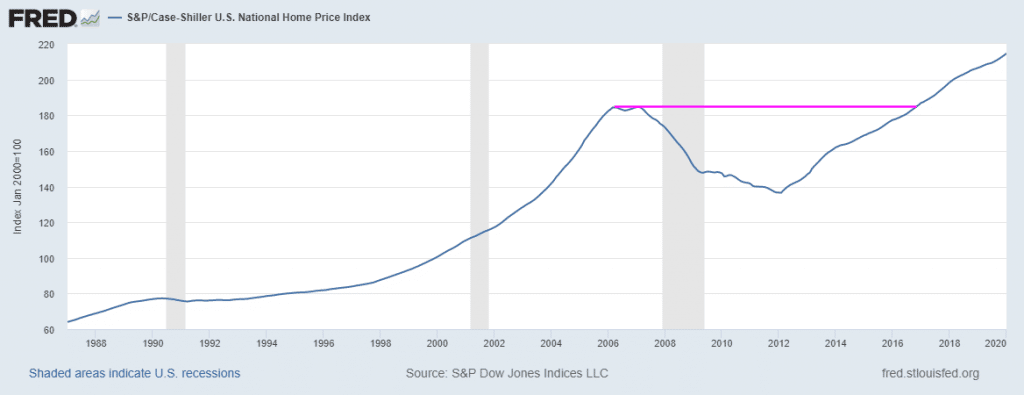
Currently, using the Realtor.com Hotness Index (https://www.realtor.com/research/reports/hottest-markets/ ), we can see that data reported in December 2019 shows a moderate shift away from certain “hot” areas in larger market areas. Pay attention to how the RED colors in 2018 have changed (in some areas) compared to Q1 2019 levels on these charts below. We believe the continued shift towards a Real Estate recession is currently taking place and that these Hotness areas will suddenly cool very quickly as new data is published.
California Hotness Map

Florida Hotness Map

New York Hotness Map

Fresh data released today from Realtor.com
Fresh data released today from Realtor.com data (updated on 4/2/2020: https://www.realtor.com) suggests a peak in the housing market may be setting up. Total active listings have declined steadily over the past 4+ years while median price levels have continued to climb. This is a sign that the Real Estate market has been within a moderately tight “seller’s market” where buyers are competing for the best properties. The Increase (Blue) to Decrease (Orange) data suggests that price levels tend to stabilize in Q4 of each year where sellers are unwilling to move away from their expected listing price. Q1 through Q2 see dramatic increases in both levels of price alterations as the activity level tends to flatten out in the early portion of each year.
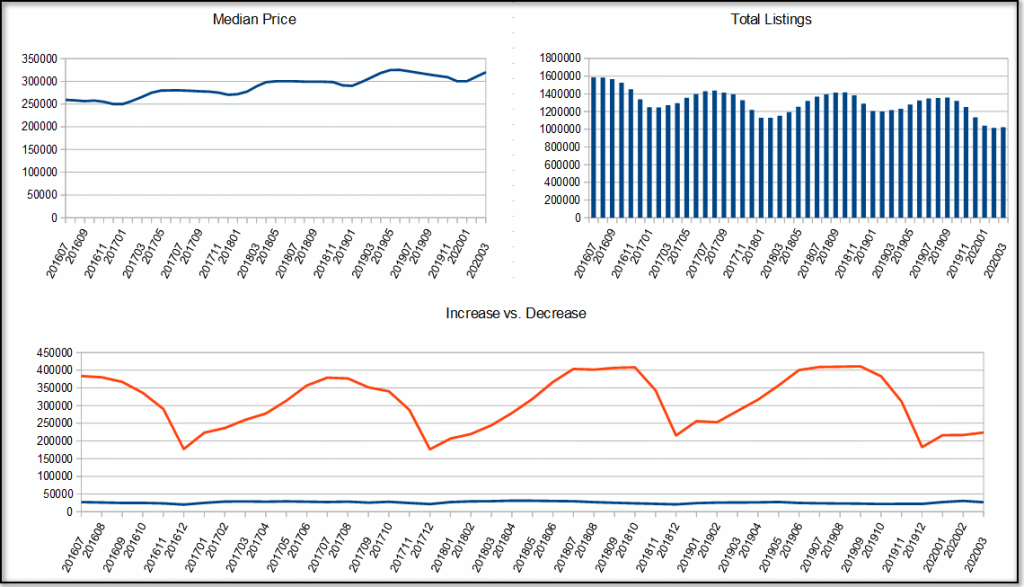
Concluding Thoughts:
Our conclusion from this data is that sellers may become increasingly desperate to reprice assets if a shift in the Real Estate market dynamics takes place as a result of the COVID-19 virus event. As of July 2019, price level decreases reached the highest levels over the past 4+ years reaching 30% of all total listings. Currently, this ratio for March 2020 is at 21.8% and is certain to climb higher.
As the human process of dealing with this virus crisis event continues to take place, we are certain that asset values and expectations will shift as they have in the past. Jobless numbers hit again today with another massive 4.42 million new jobless claims over the past week. Take a look at the charts below to see just how dramatic this event is turning out to be for American workers.
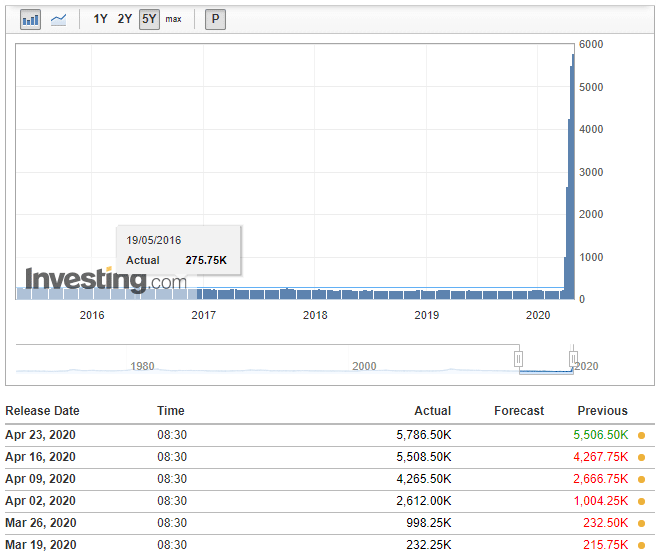
Anyone expecting the Real Estate market to survive this massive virus event unscathed is simply not seeing the data as clearly as one should. We believe once the data starts to breakdown to really show the contraction in activity, price, and expectations, then a new Real Estate recessionary trend will take place where real values will attempt to establish a true bottom. Our belief is this process may take as long as 18+ months to really bottom out and the true bottom really depends on when consumers transition away from the fear and helplessness phases and start to become optimistic again.
I am hoping people can see what I am trying to warn about, which is the next major market crash, much worse than what we saw in March. See this article and video for a super easy to understand the scenario that is playing out as we speak, and real estate will follow.
As a technical analyst and trader since 1997, I have been through a few bull/bear market cycles in stocks and commodities. I believe I have a good pulse on the market and timing key turning points for investing and short-term swing traders. 2020 is going to be an incredible year for skilled traders. Don’t miss all the incredible moves and trade setups.
Subscribers of my ETF trading newsletter had our trading accounts close at a new high watermark. We not only exited the equities market as it started to roll over in February, but we profited from the sell-off in a very controlled way with TLT bonds for a 20% gain. Yesterday we closed out SPY ETF trade taking advantage of this bounce and our account is at another all-time high value. Exciting times for us technical traders!
I hope you found this informative, and if you would like to get a pre-market video every day before the opening bell, along with my trade alerts. These simple to follow ETF swing trades have our trading accounts sitting at new high water marks yet again this week, not many traders can say that this year. Visit my Active ETF Trading Newsletter.
We all have trading accounts, and while our trading accounts are important, what is even more important are our long-term investment and retirement accounts. Why? Because they are, in most cases, our largest store of wealth other than our homes, and if they are not protected during a time like this, you could lose 25-50% or more of your entire net worth. The good news is we can preserve and even grow our long term capital when things get ugly like they are now and ill show you how and one of the best trades is one your financial advisor will never let you do because they do not make money from the trade/position.
If you have any type of retirement account and are looking for signals when to own equities, bonds, or cash, be sure to become a member of my Long-Term Investing Signals which we issued a new signal for subscribers.
Ride my coattails as I navigate these financial markets and build wealth while others lose nearly everything they own during the next financial crisis.
Chris Vermeulen
Chief Market Strategies
Founder of Technical Traders Ltd.

